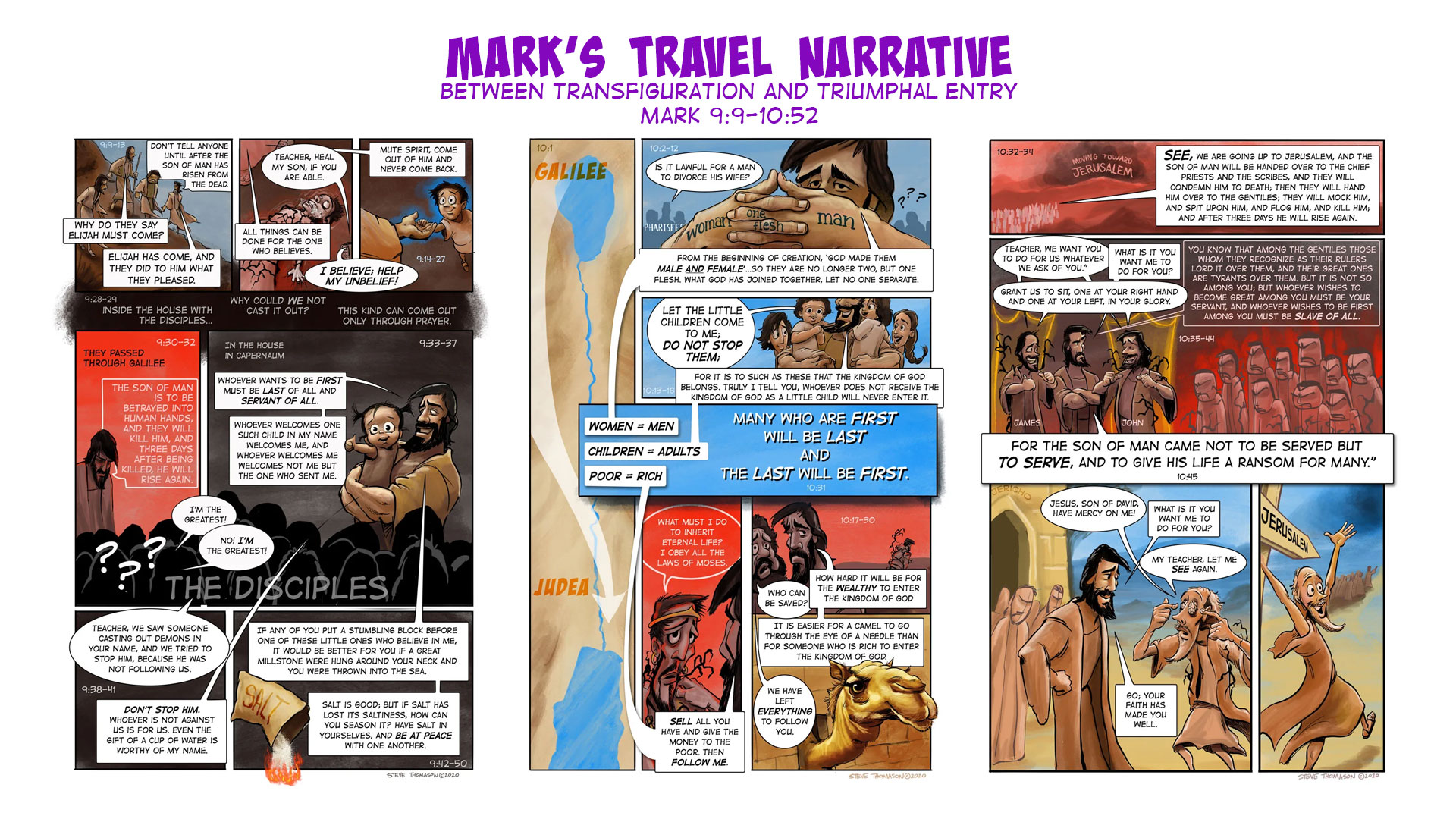Bartimaeus Healed
Page 15
Mark 10:32-52

Preview PowerPoint
[slideshare id=229243700&doc=acartoonistsguidetomark1032-52-200226195457&w=800]
Visual Commentary
Mark 10:32-34

Notice the first word: See. It seems this is the point of Mark. A key framing story happens back in Mark 8:22-26 (page 11) when Jesus heals a blind man. It takes two tries. At first, the man can see, but people seem like trees to him. Jesus touches him again and everything becomes clear.
The Gospel of Mark is presenting Jesus as the Messiah who must suffer, die, and rise again. This is the third time he tells this to his disciples.
They don’t see it.
Mark 10:35-45

Here is a prime example of how the disciples don’t see what Jesus is saying to them. James and John want glory and power. The other disciples don’t want them to have it (implying that they want it for themselves).
Jesus reminds them that his kingdom is not like the kingdoms constructed by human desires. Leaders in God’s Kingdom are not tyrants, they are servants.
They don’t see it.
Mark 10:46-52

Jericho seems to be a critical city in the Jesus story (compare Mark’s story to the Matthew and Luke). Another Joshua (Jesus is the Greek form of Joshua, remember) encountered this city first in his march into the Promised Land.
Walls came down that day through faith and obedience, not war.
Perhaps Jericho is the place where we get to see the tone of the battle. Jesus encounters a blind man.
 Notice the parallel between Jesus’ conversation with James and John and his conversation with Bartimaues.
Notice the parallel between Jesus’ conversation with James and John and his conversation with Bartimaues.
They all ask Jesus to do something for them.
Jesus responds, “What do you want me to do?”
J & J want glory and power.
Bart wants to see.
I think Bart gets it. Now he sees and the disciples are still in the dark.
On to Jerusalem…
Mark’s Travel Narrative (part 3 of 3)
Each of the Synoptic Gospels–Matthew, Mark, and Luke–have a section of the story that happens between Jesus’ Transfiguration in the north and his Triumphal Entry into Jerusalem. This section is sometimes called the Travel Narrative. Each Gospel author uses this section to highlight a specific aspect of Jesus’ teaching. Matthew presents the Community Discourse in this section. Luke spends ten chapters for this section and uses it to present the bulk of Jesus’ teaching about the Kingdom of God.
Notice what Mark does. It has a chiastic structure, which is a Hebrew literary form that places the main point at the middle of the text like a symmetrical shape C-B-A-B-C. When you see all of these stories laid out you can see the pattern
The Disciples’ inability to heal. Warning about imminent death in Jerusalem. Argument about greatness. Teaching about value. SEE, we’re going to Jerusalem. Arguments about Greatness. Healing of sight.
To simplify, it seems that Mark wants us to see that the main point is to SEE.
Jesus heals when the disciples can’t. The disciples are blind about greatness. SEE, The disciples are blind about greatness. Jesus heals the blind man who can SEE.
I could be totally wrong about the structure. However, the fact that Mark deals with the disciples’ misunderstanding of greatness two times in such a short section, seems to indicate that this is a major point Mark wants to make in his travel narrative.


